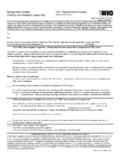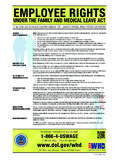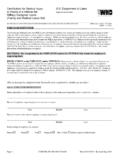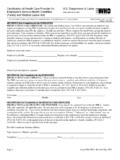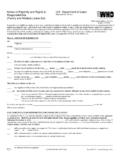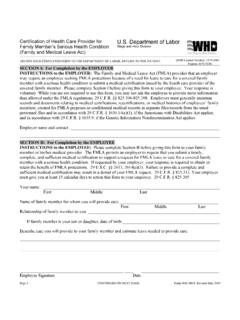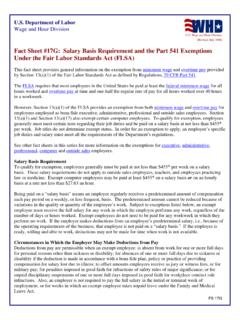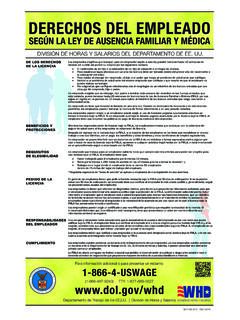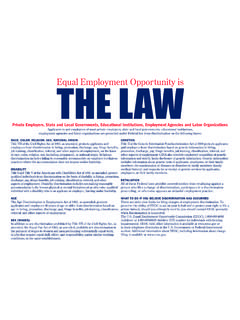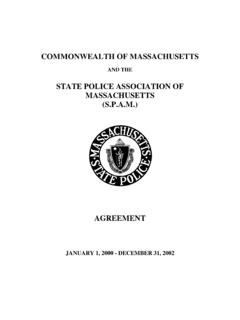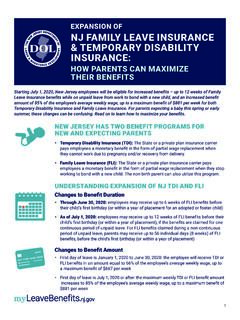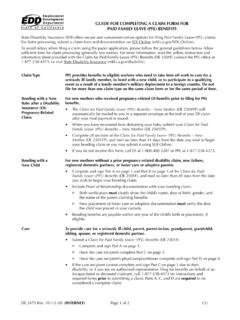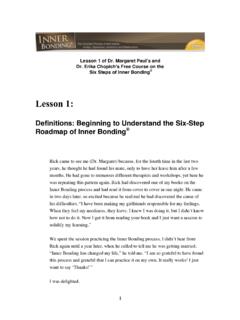Transcription of U - DOL
1 Department of Labor Wage and Hour Division (July 2015) fact sheet #28B: FMLA leave for birth, placement, bonding , or to care for a child with a serious health condition on the basis of an in loco parentis relationshipThe Family and Medical leave Act (FMLA) entitles an eligible employee to take up to 12 workweeks of job-protected unpaid leave for the birth or placement of a son or daughter, to bond with a newborn or newly placed son or daughter, or to care for a son or daughter with a serious health condition. See 29 USC 2612(a)(1).
2 This fact sheet provides guidance on an employee s entitlement to FMLA leave to bond with or care for a child to whom the employee stands in loco parentis. You may also wish to review fact sheet #28C on FMLA leave to care for a parent on the basis of an in loco parentis relationship. FMLA definition of son or daughter The FMLA defines a son or daughter as a biological, adopted, or foster child, a stepchild, a legal ward, or a child of a person standing in loco parentis. See 29 USC 2611(12). The broad definition of son or daughter is intended to reflect the reality that many children in the United States live with a parent other than their biological father and mother.
3 Under the FMLA, an employee who actually has day-to-day responsibility for caring for a child may be entitled to leave even if the employee does not have a biological or legal relationship to the child. The definition of son or daughter is limited to children under the age of 18 or 18 years of age or older and incapable of self-care because of a mental or physical disability. See 29 USC 2612(12). The FMLA military leave provisions have specific definitions of son or daughter that are unique to those provisions. See 29 (g), (h).
4 What does in loco parentis mean under FMLA? In loco parentis refers to a relationship in which a person puts himself or herself in the situation of a parent by assuming and discharging the obligations of a parent to a child. The in loco parentis relationship exists when an individual intends to take on the role of a parent to a child who is under 18 or 18 years of age or older and incapable of self-care because of a mental or physical disability. Although no legal or biological relationship is necessary, grandparents or other relatives, such as siblings, may stand in loco parentis to a child under the FMLA as long as the relative satisfies the in loco parentis requirements.
5 Under the FMLA, persons who are in loco parentis include those with day-to-day responsibilities to care for or financially support a child. Courts have indicated some factors to be considered in determining in loco parentis status include: the age of the child; the degree to which the child is dependent on the person; the amount of financial support, if any, provided; and the extent to which duties commonly associated with parenthood are 28B - 2 - The fact that a child has a biological parent in the home, or has both a mother and a father, does not prevent an employee from standing in loco parentis to that child.
6 The FMLA does not restrict the number of parents a child may have. The specific facts of each situation will determine whether an employee stands in loco parentis to a child. Examples of in loco parentis Examples of situations in which FMLA leave may be based on an in loco parentis relationship include: A grandfather may take leave to care for a grandchild whom he has assumed ongoing responsibility for raising if the child has a serious health condition. An aunt who assumes responsibility for caring for a child after the death of the child s parents may take leave to care for the child if the child has a serious health condition.
7 A person who will co-parent a same-sex partner s biological child may take leave for the birth of the child and for bonding . What may be required to document an in loco parentis relationship? The employer s right to documentation of family relationship is the same for an individual who asserts an in loco parentis relationship as it is for a biological, adoptive, foster or step parent. Such documentation may take the form of a simple statement asserting the relationship. For an individual who stands in loco parentis to a child, such statement may include, for example, the name of the child and a statement of the employee s in loco parentis relationship to the child.
8 An employee should provide sufficient information to make the employer aware of the in loco parentis relationship. See 29 CFR In loco parentis status and other FMLA requirements In loco parentis status under the FMLA does not change the law s other requirements, such as those regarding coverage, eligibility, and qualifying reasons for leave . All requirements must be met for FMLA protections to apply. An employee asserting a right to FMLA leave for birth, bonding , or to care for a child for whom he or she stands in loco parentis may be required to provide notice of the need for leave and to submit medical certification of a serious health condition consistent with the FMLA regulations.
9 Where to Obtain Additional Information For additional information about the FMLA, visit the Wage and Hour Division Website, and/or call our toll-free helpline, 1-866-4- USWAGE (1-866-487-9243) available 8 to 5 in your time zone. This publication is for general information and is not to be considered in the same light as official statements of position contained in the regulations. Department of Labor Frances Perkins Building 200 Constitution Avenue, NW Washington, DC 20210 1-866-4-USWAGE TTY: 1-866-487-9243 Contact Us
